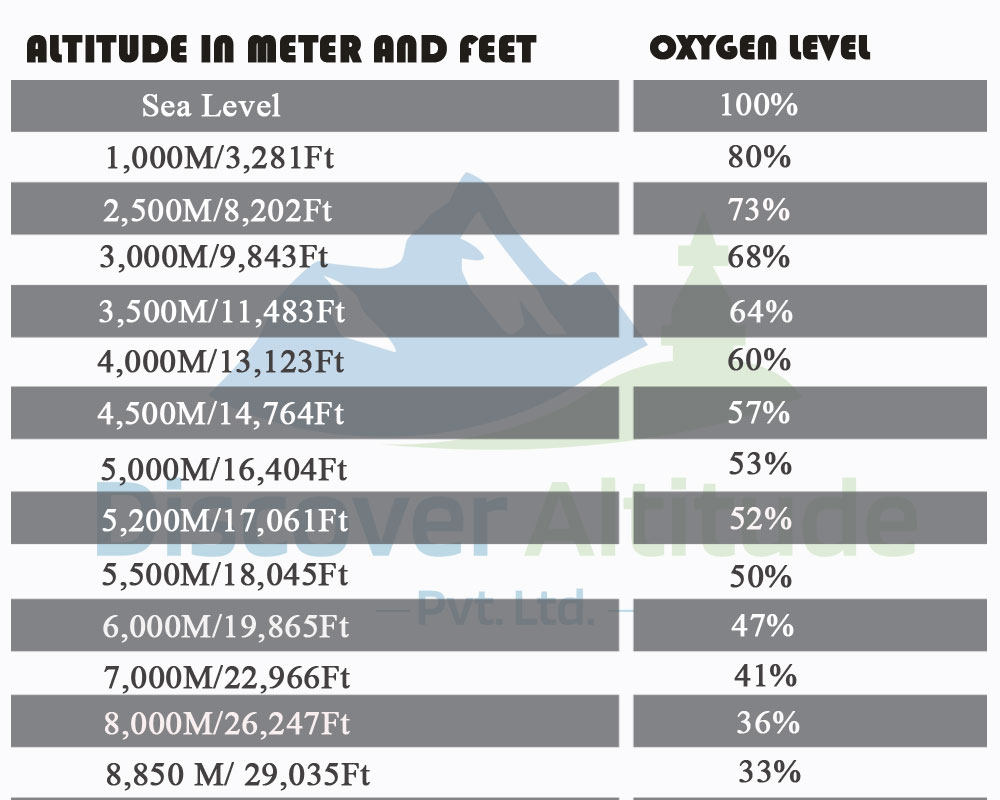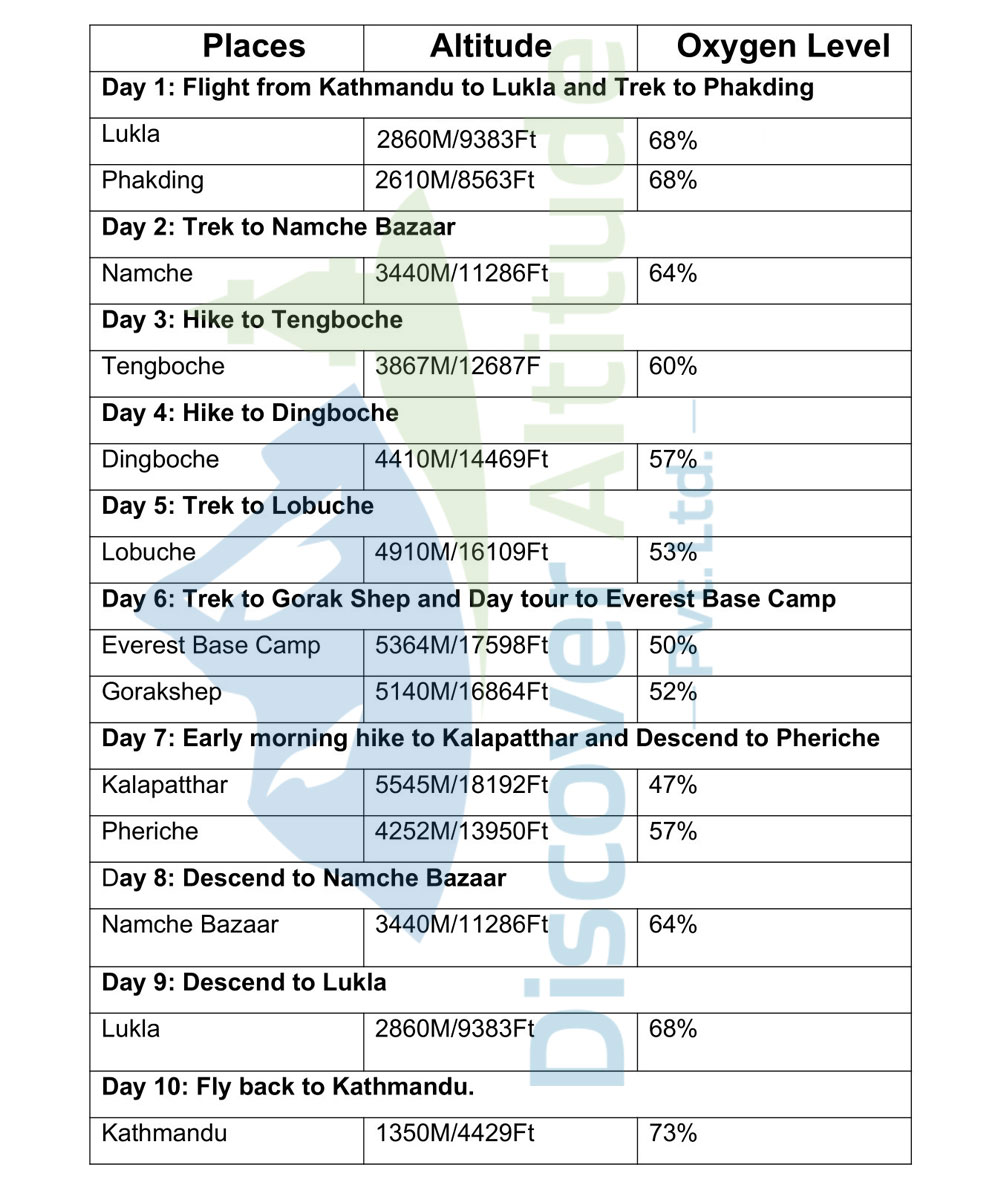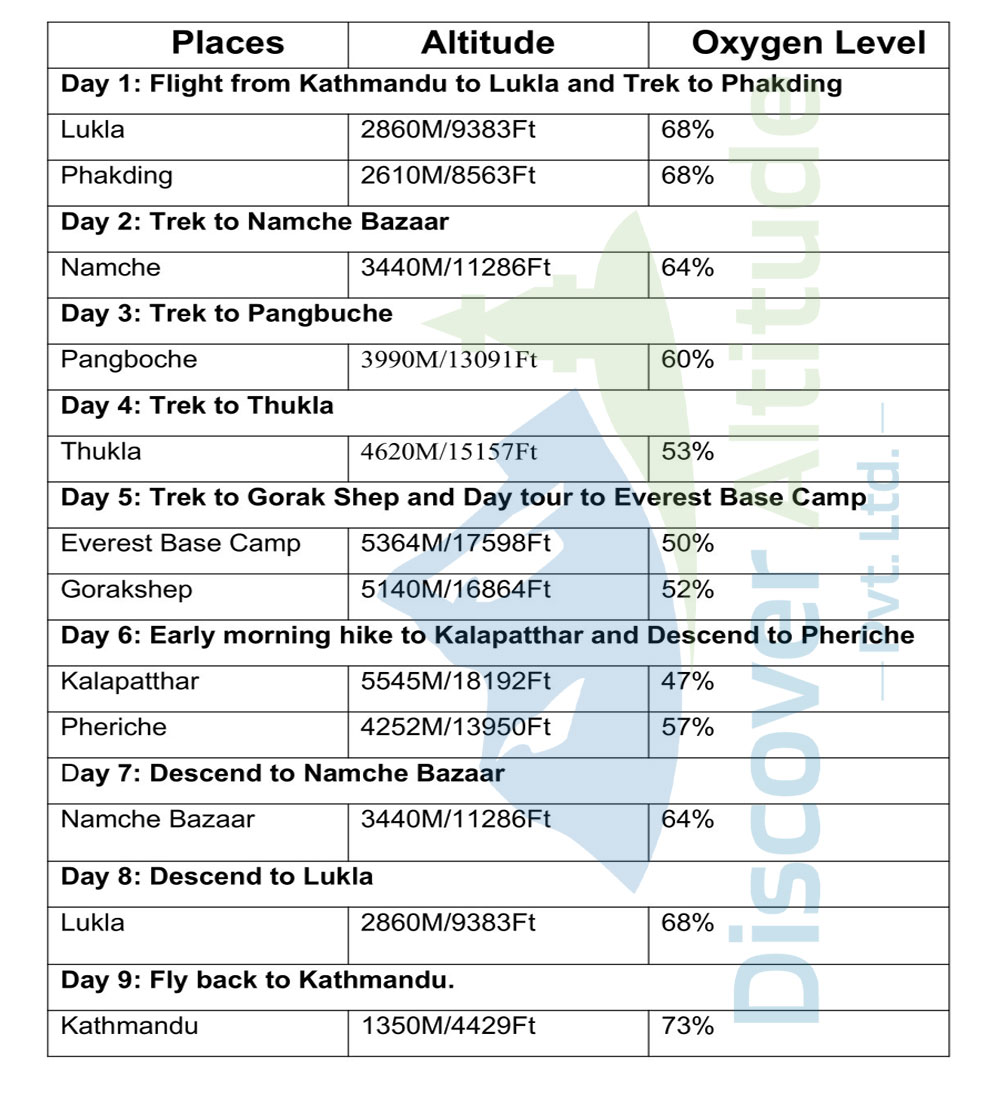Everest Base Camp Trek Altitude with Oxygen Level will help trekkers to know how to acclimatize to the level of oxygen while trekking into Everest. This is a guide for first-time trekkers to know how the rise of altitude decreases the level of Oxygen and makes it thinner.
EVEREST TREK is one of the wonders for adventure lovers and is a dream destination for trekkers. The mighty Himalayas, the surrounding ecology, and the cultural combo of the local Sherpa Community are the highlights of the entire trek.
However, trekking to Everest Base Camp is not an easy task for many. Everest Trek is regarded as a challenging hike mainly due to its TWO important factors 1. Terrain and 2. Altitude.
Everest Trek will be going uphill into the Himalayas, starting your trek from LUKLA (2860M) to the Base Camp of Mount Everest (5364M). This will be an ascend of 2504 Meters only in 6-8 Days and the same way descend to LUKLA in just 3 Days depending upon the itinerary you follow.
Trekkers mainly used 2-extra day as an acclimating day while trekking to Everest Base Camp. This helps their body to acclimatize with the change in altitude as the level of OXYGEN decreases with the gain in ALTITUDE.
Moreover, this does not apply to all trekkers. If you are physically fit and have some hiking experience, you can easily trek to Everest Base Camp (Both Way) following the best short 9-Day Everest Base Camp Itinerary.
Below is the CHART that shows how the RISE OF ALTITUDE results in DEMINISH THE LEVEL OF OXYGEN.
Relative Oxygen Rate at different altitudes:

Preparation for the EVEREST TREK must be done according to the Altitude and the Level of Oxygen. This increases the possibility of reaching the base of the highest mountain on earth, Mount Everest.
Now, the first thing a first-time trekker must know while hiking in the Himalayas is the Altitude and then the level of Oxygen that follows accordingly.
During the Everest Base Camp Trek, your first-day hike starts after landing at LUKLA AIRPORT (2,860M), which is still high for hikers who come from the SEA LEVEL. When you start your hike from Lukla, the level of oxygen is just 68%.
Here, when you reach the Base Camp of Everest, the level of OXYGEN DECREASES and goes to 50%. This is quite challenging for trekkers if your body doesn’t get proper acclimatization.
Thus, to make your trek to the Base Camp a success, listen to your body and maintain the pace, let your body acclimatize with the thin air, and make sure you are breathing comfortably. If not, stop for a break.
The Best and Easy followed Itinerary for the Everest Base Camp Trek goes accordingly:
PROGRAM 1:
Day 1: Flight from Kathmandu to Lukla and Trek to Phakding

Day 2: Trekking to Namche Bazaar

Day 3: Acclimatization Day, Hike to Everest View Hotel

Day 4: Trek to Tengbuche

Day 5: Trek to Dingbuche

Day 6: Acclimatization Day, Hike to Nangkartsang Hill

Day 7:Trek to Lobuche

Day 8: Trek to Everest Base Camp and Descend to Gorakshep

Day 9: Early morning Hike to Kalapatthar and descend to Pheriche

Day 10: Descend to Namche Bazaar
Day 11: Descend to Lukla

Day 12: Flight to Kathmandu

Following the above-mentioned itinerary helps trekkers to acclimatize to the altitude and cope with the Oxygen level of the Himalayas. This makes the trek easy with a 100% possibility for any trekkers to step at the Base Camp of Mount Everest.
This 12-Day Everest Base Camp Trek is doable for any level of trekkers and is a highly recommended Itinerary even for first-time hikers.
However, the best way to trek the Himalayas is to follow the universally accepted proverb, that is ‘HIKE HIGHER AND SLEEP LOWER’.
This simply means that, when a trekker is trekking at a high altitude, they must make sure that they are hiking around 100 Meters higher than the overnight camp. Spending an hour or half at that altitude will help your body to acclimatize to the environment and the Oxygen and finally descend to the lower altitude to spend a night.
PROGRAM 2:

Still worried about a long vacation but desperate to trek Everest Base Camp, then the second option will be a 10-day Everest Base Camp Trek. This is a well-designed Itinerary with just skipping 2-extra acclimatizing days.
Here, trekkers' pace of Hike is just 6 hours per day at a nominal pace, exploring the exotic beauty of the Himalayas, and visiting the monastery and the local Sherpa villages. Here, the gain in altitude is not higher and is easily doable for first-time trekkers as well.
PROGRAM 3:

This 9-DAY EVEREST BASE CAMP TREK ITINERARY mentioned above is recommended for those trekkers who are restricted with time limitations and are fit for long hikes. This will be a hike of 7-8 hours every day without any acclimatizing day.
However, we recommend this 9-Day Everest Trek to only those who are physically fit and have some basic training in Alpine hike which means you need to hike longer every day compared to another trekking itinerary.
9-Day EBC Trek is the SHORTEST way to hike Everest Base Camp from Kathmandu to Kathmandu.
OTHER ALTERNATIVE OPTIONS TO HIKE EVEREST BASE CAMP MOST SHORTLY:
Apart from the above-mentioned itinerary, there are multiple ways to hike the Base Camp of Everest. If you are worried about your age and physical fitness and have enough days. Then, the perfect itinerary can be the EVEREST BASE CAMP TREK FOR SENIORS.
This is a more relaxing way to trek Base Camp, making the overnight camp shorter and the hours of hike less as compared to other alternative packages.
Here, you will get sufficient time to explore the EVEREST REGION, culture, tradition, and religion of the local Sherpa People. Furthermore, your body will easily acclimatize to the altitude of the Himalayas.
Now, for trekkers who want to avoid the same trail to descend from Everest Base Camp to Kathmandu or Lukla. The possible Itinerary will be to take a Helicopter Tour, explore the Everest Region, and descend back to Lukla or Kathmandu on the same day.
This will lessen 4-Day all the way descending from Everest Base Camp to Kathmandu or Lukla. So, still, the best possible short way to trek Everest will beEVEREST BASE CAMP TREK WITH A HELICOPTER RETURN.
Those are just some to Mention. Further, if you have just a limited number of days but want to hike in the Everest Region and step at the Base Camp. Then, you can select a unique package of NAMCHE BAZAAR TREK WITH EVEREST BASE CAMP HELICOPTER TOUR.
This will be just a 3 to 4-day package to explore the Everest Region and the Base Camp in the super fastest way which is doable for any age group.
However, for those who don’t want to trek but want to explore the Everest Region including the Base Camp. Everest Base Camp Helicopter Tour will be an easy option for just a day tour.
Further, if you are still confused about how to select the best option. There are multiple ways to CUSTOMIZE, please contactDISCOVER ALTITUDE TREKSor WHATSAPP:+977-9841161593 to have a conversation.















